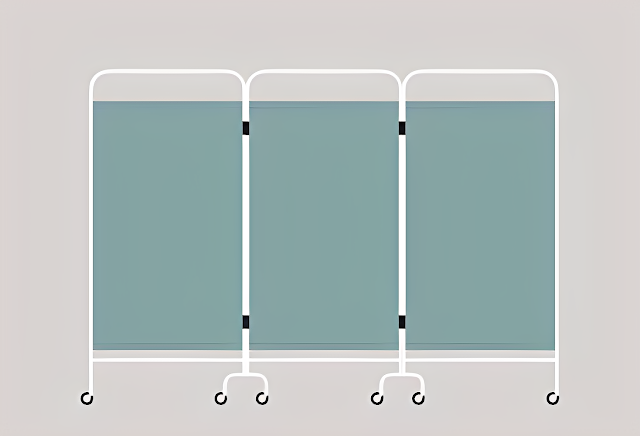The Key Role Of Commercial Privacy Screens In Enhancing Patient Comfort In Hospitals
February 06, 2024Introduction
The provision of comfort in medical settings is paramount to patients' well-being. It transcends the physical alleviation of symptoms and manifests in the psychological ease and emotional relaxation that patients experience throughout the healing process. One such aspect of patient comfort, that is seldom seen under the limelight yet bears significant importance is an entity of the hospital interior design - commercial privacy screens.
Hospital designs are developed keeping in mind the primary purpose of facilitating well-being and recovery. Amidst the hustle-bustle of daily hospital activities, patients require some semblance of peace and tranquility, and commercial privacy screens provide just that. These discreet partitions offer a tangible, intimate space that instills a sense of serenity, making patients feel more at ease. This piece aims to shed light on the power of commercial privacy screens in improving patients' comfort and contributing to their overall recovery journey.
The Anatomy Of Commercial Privacy Screens: More Than Meets The Eye
Commercial privacy screens are in essence, carefully engineered structural elements designed to enhance privacy while contributing to the aesthetic value of the environment. Essentially, they are mobile or fixed barriers that segregate the patients' region and add a dash of design to the medical ward. Made from easy-to-clean and scratch-resistant materials like vinyl or fabric, these screens are designed to be practical and long-lasting.
The design and structure offer versatile usage, from creating private cubicles for patients to forming sections for visitors or doubling up as room dividers in shared spaces. Adapting to multiple settings, these screens provide an opportunity to manage space more innovatively. Different screens come with distinct features – some are foldable, others have casters for easy mobility, and some offer noise reduction benefits. But no matter the variation, the underlying aim remains the same – increasing patient comfort and privacy.
Building A Haven: The Role Of Privacy Screens In Enhancing Patient Comfort
Comfort and privacy are interlinked. An environment nurturing privacy invariably boosts patient comfort, which in turn aids in recovery. Commercial privacy screens contribute significantly to fostering this atmosphere of peace and privacy. They create a small, personal space within the otherwise sprawling hospital premise which can be particularly calming during times of physical or emotional unrest.
Numerous studies have annexed the hypothesis that comfortable patients recover faster and more effectively. Being comfortable stimulates a positive psychological response which has been observed to induce better sleep, lesser anxiety, and improved tolerance to pain – elements that directly or indirectly contribute to healing. The role of privacy screens in creating this comfort-focused environment, therefore, is critical.
Bringing Design To The Frontline: Innovations In Privacy Screen Designs
Design evolution in the medical field has embraced the concept of ‘healing architecture’ where the premises are designed to optimally cater to healing and recovery. Commercial privacy screens have evolved rapidly from bland, plastic partitioning to aesthetically pleasing elements that are as much about the visual appeal as they are about functionality.
Today, some screens incorporate elements like illuminated panels for a soothing atmospheric effect or the use of antimicrobial fabric for greater health safety. Innovative designs with integrated storage spaces or writable surfaces have also emerged, further enhancing utility. These added features not only facilitate a better patient experience due to their utility but also contribute to a pleasant visual addition to the hospital spaces.
The Integration Of Privacy Screens Within The Spectrum Of Hospital Design
Commercial privacy screens are an integral part of the broader hospital design. They haven't just filled a functional need but also have perfectly blended with other design elements like lighting, colour schemes, and layout. For instance, privacy screens with translucent panels can soften harsh and varied lighting, aiding in creating a relaxed environment.
Screens play a critical role in defining space and controlling the flow of the area. They can serve as room dividers, create personal recovery corners, or even help manage visitor areas, depending on the need. Therefore, they stand at the intersection of design and utility in hospital spaces.
Clear Vision, Clear Screens: Maintenance And Cleaning Of Privacy Screens
The longevity and performance of commercial privacy screens are dependent on regular maintenance and cleaning, especially in a hospital setting. Soiled or damaged screens not only reduce the visual appeal but can also harbour germs, hence regular cleaning using appropriate cleaning agents is recommended.
General maintenance tips include checking for damages in the moving parts of mobile screens or regular inspection for fabric tears in curtain screens. Such proactive checking can ensure the screens remain functional and aesthetically pleasing over time.
Future Forward: Exploring The Next Step For Commercial Privacy Screens
As technology advances, commercial privacy screens are expected to become more innovative. Screens with integrated tech features, personalized design options, and environmentally friendly materials may soon be the norm. Furthermore, there could also be advancements in terms of better infection control and noise reduction properties.
Case Study: Transforming Spaces With Screens
The Royal Melbourne Hospital provides an excellent example of how privacy screens significantly enhance hospital spaces. Here, commercial privacy screens were strategically incorporated to create intimate patient spaces within an otherwise broad and open ward. This boosted patient comfort by ensuring privacy and reducing noise. The screens also highlighted features such as the flexibility to adjust the size of the privacy area as needed and easy-to-clean surfaces for optimized hygiene.
Conclusion
Commercial privacy screens may often be overlooked, but their contribution to patient comfort in hospitals is immense. Not only do they facilitate personal spaces, reduce noise, and enhance the visual appeal, but they also indirectly aid in faster patient recovery - an evidence-backed fact that solidifies their importance in hospital design. As designs evolve, these screens are slated to grow more innovative, coalescing form, function, and technology, and continuing their role in enhancing comfort and contributing to a better recuperation journey for patients.




0 comments